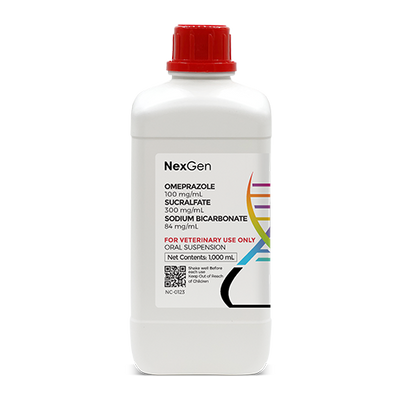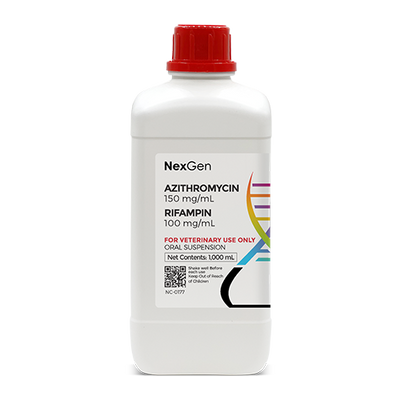
Omeprazole 100 mg/mL + Cimetidine 100 mg/mL, Oral Suspension, 1000mL
Login for pricing
- Brand
- Mixlab
- SKU:
- NC-0135
- Product Type:
- Suspension
- Size:
- 1000ml
- Administration:
- Oral
It is estimated that between 50% to 90% of horses suffer from gastric ulcers at one time or another. These can affect any horse at any age, but typically occur in performance horses. Strenuous exercise increases gastric acid production and decreases blood flow to the gastrointestinal tract, which is thought to be a factor in bringing on this condition.1Additionally, when horses engage in heavy exercise, acidic fluid in the stomach splashes and exposes the more vulnerable upper portion of the stomach to high acidity. The prevalence of gastric ulceration in Thoroughbreds in race training varies from 70% to 94%, and most sport horses are similarly affected.2
Since horses have a relatively small stomach compared to other species of similar size, they are frequent grazers because they can only handle relatively small amounts of food. “In a natural grazing situation, a steady flow of acid is required for digestion, so a horse’s stomach produces acid 24 hours a day, 7 days a week – up to 9 gallons of acidic fluid per day, even when not eating. In a natural, high-roughage diet, the acid is buffered by both feed and saliva. When horses are fed two times per day, which is common in many boarding situations, the stomach is subjected to a prolonged period without feed to neutralize the acid.”1
Clinical Signs of Gastric Ulcers in the Horse
Many horses suffering from gastric ulcers will not show outward clinical symptoms, but some subtle signs can include:
- Lethargy
- Poor appetite
- Behavioral changes
- Decreased performance
- Poor body condition
- Poor coat
- Weight loss
- Colic1
In serious cases, horses may present with abdominal pain and/or grinding of the teeth.1,2 Occasionally, a horse with advanced ulcerative disease may be found on its back. This is more common with foals, and it is believed that this position provides relief from the pain associated with acidic fluids bathing sensitive parts of the stomach. Some horses will walk away from food if they experience discomfort with the first mouthful.1
In foals, the clinical signs of ulcerative disease include intermittent colic, frequent recumbency, reduced nursing, diarrhea, poor appetite, a pot-bellied appearance, grinding of teeth, and excess salivation.1 When foals exhibit clinical signs of ulcers, they should be diagnosed and treated immediately, because the ulcers are likely to be severe.
Diagnosis and Treatment of Gastric Ulcers
Gastric ulcers may be diagnosed most accurately via gastric endoscopy (gastroscopy), although the veterinarian may make a tentative diagnosis based on clinical signs and how the horse responds to therapy.
Omeprazole is a proton pump inhibitor that is often used to treat GI ulcers and erosions.3 Omeprazole is useful in the treatment of both gastroduodenal ulcer disease and prevention or treatment of gastric erosions caused by ulcerogenic drugs (eg, aspirin, NSAIDs).
For the treatment of gastric ulcers in horses, the recommended dosage of omeprazole is 4 mg/kg PO every 24 hours for 4 weeks. To prevent recurrence of ulcers, the dosage is 2 mg/kg PO every 24 hours for at least another 4 weeks. Doses as low as 1 mg/kg PO once daily were effective in treating squamous ulceration when administered following a brief fast and prior to exercise.4 Omeprazole is also available in paste and powder formulations that have been very effective in preventing and treating gastric ulceration in all types of horses.
Cimetidine is competitively inhibits histamine at the H2 receptors of the parietal cells, thereby reducing gastric acid output both during basal conditions and when stimulated by food, pentagastrin, histamine, or insulin.3 Gastric emptying time, pancreatic or biliary secretion, and lower esophageal pressures are not altered by cimetidine. By decreasing the amount of gastric acid secretions, cimetidine also decreases pepsin secretion. Cimetidine has an apparent immunomodulating effect, as it has been demonstrated to reverse suppressor T-cell-mediated immune suppression. It also possesses weak anti-androgenic activity.6
NOTE: Cimetidine is a CLASS 5 DRUG under the Association of Racing Commissioners International (ARCI) Uniform Classification Guidelines for Foreign Substances (UCGFS).
Where to buy Omeprazole + Cimetidine
Omeprazole + Cimetidine is available in the U.S. through several pharmaceutical manufacturers and through veterinary custom compounding companies.
This product carries several potential drug interactions. Please consult your veterinarian prior to beginning any treatment regimen.
FOR RX ONLY: A valid prescription from a licensed veterinarian is required for dispensing this medication.
1Young, A. Equine Gastric Ulcer Syndrome. In: Journal UC Davis School of Veterinary Medicine, July 29, 2019.
2Andrews, F. Gastric Ulcers in Horses. In: Merck Veterinary Manual, Jan. 2014.
3Loving, N. Research on Treatment of Equine Gastric Ulcer Syndrome. In: EquiManagement.com, Jan 13, 2019.
4Merck Veterinary Manual.
6Sykes BW, Sykes KM, Hallowell GD. A comparison of three doses of omeprazole in the treatment of equine gastric ulcer syndrome: a blinded, randomised, dose-response clinical trial. Equine Vet J. 2015;47(3):285-290.
















